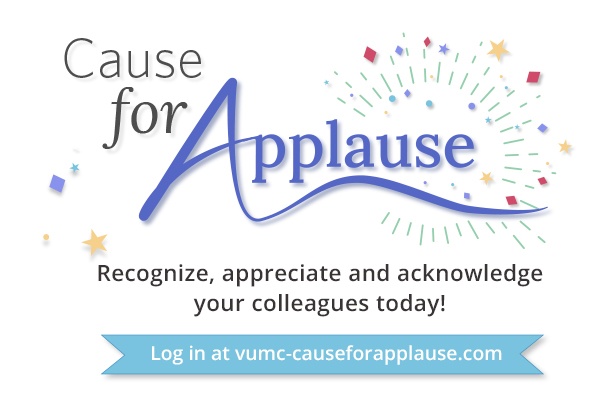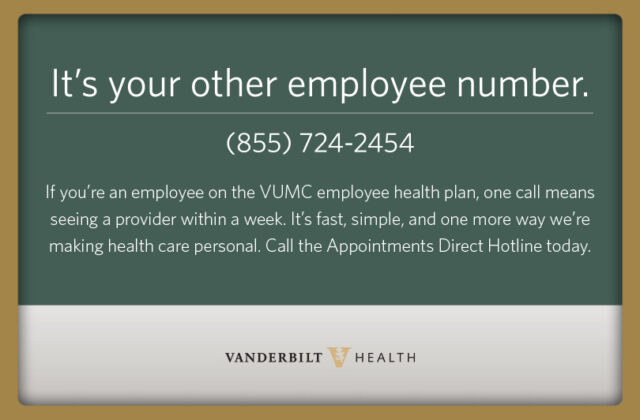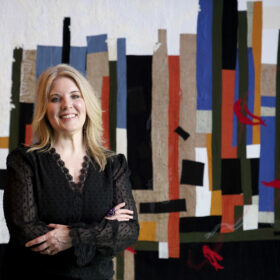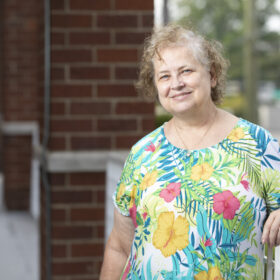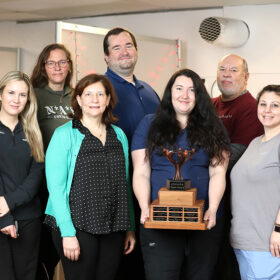The nurse was afraid her patient would die. She wrote her experience in a story that was shared by NPR.
Sue Perron, a Vanderbilt intensive care nurse, told the story of the patient with COVID she called the Butterfly Man
July 9, 2021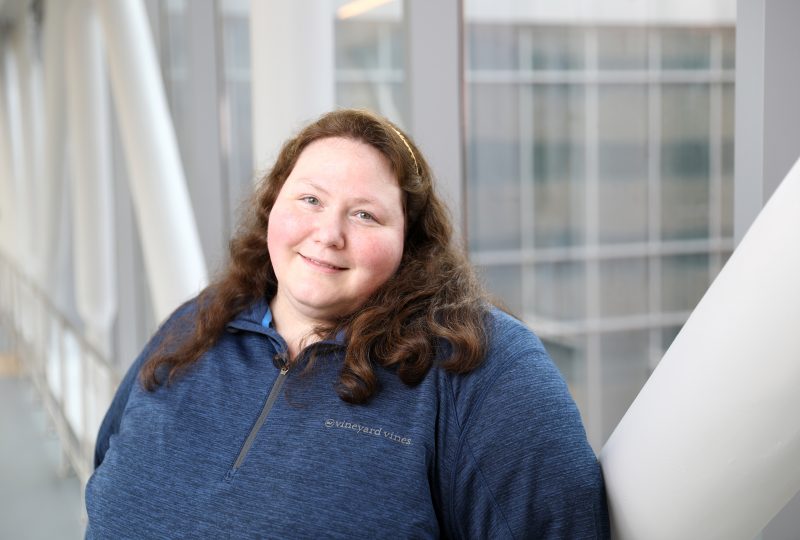
VUMC nurse Sue Perron was inspired by the prompt, “Write about a time when you knew you were in the right profession.” Photo by Erin O. Smith
When Sue Perron, RN, BSN, started college, she did not anticipate a career in nursing.
When she became a nurse, she did not anticipate moving to Tennessee to work at Vanderbilt.
And when she began working in Vanderbilt’s Medical Intensive Care Unit, she, of course, did not anticipate that a worldwide pandemic would transform her unit and the entire Medical Center.
She can now add one more item to the series of unanticipated events: When she wrote about her experience caring for a critically ill patient on the Vanderbilt COVID unit, she did not anticipate that her words would be shared nationwide by NPR.
Perron is a New Hampshire native who, after spending some time as an exchange student in Germany when she was in high school, returned to Europe to live for 10 years, including six years in Paris. While she was there she earned an undergraduate degree in European Cultural Studies at the American University. She then spent some time in Germany working for the U.S. Army as a civilian employee.
This is not a common career background for a nurse, but she says this long and winding road was the right one for her.
“I was a little older, but nursing is one of those things you have to be ready for,” she said.
She earned her nursing degree from Simmons College (now university) in Boston and, because she says she was “looking for an adventure,” she decided she wanted to live somewhere in the country outside her native New England. When she interviewed for a job at Vanderbilt, she got an offer from the Medical Intensive Care Unit (MICU), and she knew she had found her place.
That was two years ago. Nobody knew the storm that was coming.
A disease no one had seen before
When preparations were being made for the first COVID patients to be admitted to VUMC, a natural place to look for staffing was the MICU – staff were accustomed to dealing with adults with serious disease, including respiratory illness. As the plan for the new COVID unit came together, the MICU and the COVID ICU shared a lot of the same staff.
Perron was among the early volunteers to care for COVID patients, and she recalls her colleagues’ sudden realization that the skills needed to care for those patients were the ones they had been training for and using for years.
“I think we all rose to the occasion,” she said. “I work with awesome and brave colleagues.”
The staffing model changed as the number of patients and their illness severity changed, but generally the MICU nurses would work one week in the COVID ICU, rotate back to MICU for two weeks, and then back to the COVID unit.
She recalls the challenges as caregivers struggled to care for patients who were hospitalized with a disease nobody had ever seen.
“This was a new disease,” she said. “You’d walk onto the unit and a patient would seem to be doing OK. Then the O2 saturation would plummet and you’d have no idea why.
“It was very stressful. There were so many unknowns.”
“Write about a time when you knew you were in the right profession”
One night when Perron came in to begin her shift in the COVID unit, the computer screen at the nurses’ station, where official announcements and news from VUMC are posted, had information about The Things They Carry Project, a series of writers’ workshops for assisting caregivers in telling their stories.
“I had been looking for an outlet to express what I experienced in the past year and this opportunity literately popped up,” she said.
Even though Perron says that she never considered herself a writer, she signed up.
Each workshop, held on Zoom, was set up as three 90-minute small-group sessions under the guidance of a writer and a psychotherapist. (One of the writers who helps with this is Kate Daniels, MFA, professor of English at Vanderbilt, although she was not assigned to Perron’s group).
Participants, all of whom are in health care or are first responders, are given prompts to writing. They then have some time to put their thoughts or stories on paper, and then share with others in the group.
“The surprise was how much I enjoyed it,” Perron said. “There are very few people who understand what we’re going through, and we don’t have time to unpack it while we’re at work.”
Her group was made up of people from all over the U.S., and included an emergency room physician, two therapists, a nurse practitioner and an EMT.
It was on the third and final official meeting of the group that the writing prompt, “Write about a time when you knew you were in the right profession,” led Perron to think about, and then write about, the patient she called the Butterfly Man.
Here is what she wrote:
The Butterfly Man
“This is scaring me,” I told my Nurse Practitioner, as I continued to turn up my patient’s sedation, steadily climbing past the pump’s guardrails. “Is this safe?” I whispered to myself, hands trembling.
My NP looked back at me through the patient’s door and replied over my respirator’s walkie, “Yes, this is scary. We are in uncharted territory; there is no instruction manual for this.” Fentanyl, Propofol, Versed, and Nimbex, all reaching maximum dosages as I continued to titrate up. I looked at my patient, strapped to ECMO, trached, vented, hooked to countless wires monitoring vital signs, while all wrapped up in a warming blanket. And, not just any ECMO patient, but one who needed a double or “butterfly” ECMO circuit, that graced their body like wings, to keep them alive.
In street speak ECMO, (extracorporeal membrane oxygenation), is a device that can bypass blood going to the lungs (and sometimes the heart) and pumps it into a machine that filters out CO2 while delivering oxygen to the blood; then, when done, sends it back into a major artery to circulate around the body. The hope is that this will either help bridge to a lung transplant or give their lungs time to heal. It’s usually a grim prognosis by the time a COVID patient ends up on ECMO and grimmer if it’s two. A simple turn or cough could cause your patient’s oxygen levels to plummet and there was no guarantee that that their oxygen levels would recover no matter what medical miracle we perform.
“Hell,” I thought, “just looking at them could cause them to code.”
I could feel the droplets of perspiration run down my back. My green scrubs were drenched under the protected layers of blue plastics shielding me from the virus. Everything just stuck to me. The cool air from my respirator, my saving grace, fanned my sweaty face. COVID is such a heart-breaking disease. Even if your patient beats COVID their lungs may never recover causing their ultimate demise. Working in a place like the COVID ICU will test you mentally, physically and spiritually on a daily basis. This case was no exception.
My charge nurse knocked on my window. Patient’s spouse is on the phone for an update. They live almost three hours away and are now the sole caregiver for their children.
“What do I say? How do I tell someone their loved one is not doing well? How do I avoid giving them false hope?” I thought. I tell them the truth; I keep to the facts. I summarize my assessment, changes in ECMO settings, drip rates, recent labs, and goals for the evening. Sometimes my only goal is to keep them stable until next shift. It’s grim. Then I hear her sweet voice over the receiver telling me that God is looking out for us and she has all faith in my abilities as a nurse. “I’m glad someone does,” I think to myself, as I fight back the urge to cry.
I get off the phone and doubt creeps in. “What am I doing here?” I ask myself, “Am I enough? What have I gotten myself into? Am I really helping people? Am I really making a difference?” After my shifts in the COVID ICU, I leave with the sick feeling of defeat. It’s hard when you see so many of your patients die. You start guessing your every action, decision and intervention. I began doubting my convocation that led me to become a nurse. I call this phenomenon the silent killer of health care careers.
I look around and stare at all the handmade drawings, get well cards and family pictures adorning my patient’s walls, a reminder that cocooned within in this nest of wires and medical equipment is a well-loved human being. Praying, I snapped out of my funk and sprung back into action, telling my doubts, “WE are not doing this tonight.” For the rest of the shift, I focus on here and now. I focus what I can do for my patient in this moment.
As 7 a.m. approaches, the day shift, fresh from their showers and night sleep, shuffle in to get report. My patient is still alive, sedated and relatively stable. I consider this a win in my book. I did the best I could, I told myself. The rest is in God’s hands. As I leave the COVID ICU I try not to look back at my patient as it is often the last time I will see them alive. It’s too painful. I make it out to the parking garage and climb in my Corolla. Jeff Buckley’s “Hallelujah” plays over the radio. I sigh; exhausted, I kick back my seat and close my eyes for five short minutes.
Weeks passed. I try not to think of my previous patients. Just neatly compartmentalize my work life so I can carry on. Oftentimes, I have no idea what happens to my patients once they leave my care. As an ICU nurse, that is one of the luxuries I have. On this particular day it was my turn to cycle back into the “normal” Medical ICU giving me a much needed break from COVID. As I passed by the charge nurse’s desk to get my assignment, I peered into a nearby room. Looking back at me was my Butterfly Man. He waved. I smiled ear to ear.
“We are making a difference”
In June the nationally broadcast NPR show “Here and Now” covered The Things They Carry Project and chose Perron’s piece as one of the ones featured on its website.
She hopes having her story, and others like it, will help those who were not on the front lines of the pandemic understand some of what it was like for those who faced the toll of the sickest COVID patients. Her group of fellow writers have continued to meet and share stories, even after the official end of its sessions.
“[The Butterfly Man] was one of the scariest, sickest patients I took care of,” she said. “I got to see him on the other end of the tunnel. He was a reminder that we’re making a difference. Your patients are counting on you.
“Going to work in the COVID ICU was a life-changing experience. When I saw the outcome, it made me realize how much my profession matters, that nurses matter.”




